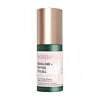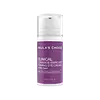What's inside
What's inside
 Key Ingredients
Key Ingredients

 Benefits
Benefits

 Concerns
Concerns

 Ingredients Side-by-side
Ingredients Side-by-side

Water
Skin ConditioningAloe Barbadensis Leaf Juice
Skin ConditioningSqualane
EmollientNiacinamide
SmoothingGlycerin
HumectantPanthenol
Skin ConditioningChondrus Crispus Extract
Skin ConditioningMalus Domestica Fruit Cell Culture Extract
Skin ConditioningAcetyl Tetrapeptide-5
HumectantAcetyl Hexapeptide-8
HumectantTocopherol
AntioxidantPentylene Glycol
Skin ConditioningCucumis Sativus Fruit Extract
EmollientTetrahexyldecyl Ascorbate
AntioxidantCamellia Sinensis Leaf Extract
AntimicrobialLycium Barbarum Fruit Extract
AstringentLycopene
AntioxidantVitis Vinifera Skin Extract
AntioxidantSodium Hyaluronate
HumectantCaffeine
Skin ConditioningAcacia Senegal Gum
MaskingDimethicone Crosspolymer
Emulsion StabilisingXanthan Gum
EmulsifyingCarbomer
Emulsion StabilisingEthyl Lauroyl Arginate Hcl
Skin ConditioningLecithin
EmollientAmmonium Acryloyldimethyltaurate/Vp Copolymer
Silica
AbrasivePhenoxyethanol
PreservativePotassium Sorbate
PreservativeCitric Acid
BufferingCaprylyl Glycol
EmollientWater, Aloe Barbadensis Leaf Juice, Squalane, Niacinamide, Glycerin, Panthenol, Chondrus Crispus Extract, Malus Domestica Fruit Cell Culture Extract, Acetyl Tetrapeptide-5, Acetyl Hexapeptide-8, Tocopherol, Pentylene Glycol, Cucumis Sativus Fruit Extract, Tetrahexyldecyl Ascorbate, Camellia Sinensis Leaf Extract, Lycium Barbarum Fruit Extract, Lycopene, Vitis Vinifera Skin Extract, Sodium Hyaluronate, Caffeine, Acacia Senegal Gum, Dimethicone Crosspolymer, Xanthan Gum, Carbomer, Ethyl Lauroyl Arginate Hcl, Lecithin, Ammonium Acryloyldimethyltaurate/Vp Copolymer, Silica, Phenoxyethanol, Potassium Sorbate, Citric Acid, Caprylyl Glycol
Water
Skin ConditioningNeopentyl Glycol Diheptanoate
EmollientCetyl Alcohol
EmollientButylene Glycol
HumectantGlycerin
HumectantGlyceryl Stearate
EmollientPEG-100 Stearate
Ammonium Acryloyldimethyltaurate/Vp Copolymer
Ascorbyl Glucoside
AntioxidantPotassium Cetyl Phosphate
EmulsifyingSodium Ascorbyl Phosphate
AntioxidantBis-Diglyceryl Polyacyladipate-2
EmollientPolyglyceryl-10 Dioleate
EmulsifyingTetrahexyldecyl Ascorbate
AntioxidantCeramide Ns
Skin ConditioningCeramide EOP
Skin ConditioningCeramide AP
Skin ConditioningCeramide Eos
Skin ConditioningCeramide NP
Skin ConditioningPalmitoyl Tripeptide-5
Skin ConditioningAcetyl Tetrapeptide-5
HumectantCaprooyl Phytosphingosine
Skin ConditioningCaprooyl Sphingosine
Skin ConditioningCholesterol
EmollientSqualane
EmollientRetinol
Skin ConditioningVitis Vinifera Seed Extract
AntimicrobialGlycyrrhiza Glabra Root Extract
BleachingPunica Granatum Fruit Extract
AntioxidantDunaliella Salina Extract
Skin ConditioningPongamia Glabra Seed Oil
Skin ConditioningTocopheryl Acetate
AntioxidantAllantoin
Skin ConditioningBisabolol
MaskingCarnosine
Skin ConditioningPanthenol
Skin ConditioningSodium PCA
HumectantPullulan
Glyceryl Ascorbate
AntioxidantBehenic Acid
CleansingDimethicone
EmollientSodium Citrate
BufferingSodium Polyacrylate
AbsorbentCaprylyl Glycol
EmollientEthylhexyl Stearate
EmollientCeteareth-25
CleansingSodium Hydroxide
BufferingTrideceth-6
EmulsifyingPropyl Gallate
AntioxidantPolysorbate 20
EmulsifyingDisodium EDTA
Mica
Cosmetic ColorantPhenoxyethanol
PreservativeChlorphenesin
AntimicrobialSodium Benzoate
MaskingWater, Neopentyl Glycol Diheptanoate, Cetyl Alcohol, Butylene Glycol, Glycerin, Glyceryl Stearate, PEG-100 Stearate, Ammonium Acryloyldimethyltaurate/Vp Copolymer, Ascorbyl Glucoside, Potassium Cetyl Phosphate, Sodium Ascorbyl Phosphate, Bis-Diglyceryl Polyacyladipate-2, Polyglyceryl-10 Dioleate, Tetrahexyldecyl Ascorbate, Ceramide Ns, Ceramide EOP, Ceramide AP, Ceramide Eos, Ceramide NP, Palmitoyl Tripeptide-5, Acetyl Tetrapeptide-5, Caprooyl Phytosphingosine, Caprooyl Sphingosine, Cholesterol, Squalane, Retinol, Vitis Vinifera Seed Extract, Glycyrrhiza Glabra Root Extract, Punica Granatum Fruit Extract, Dunaliella Salina Extract, Pongamia Glabra Seed Oil, Tocopheryl Acetate, Allantoin, Bisabolol, Carnosine, Panthenol, Sodium PCA, Pullulan, Glyceryl Ascorbate, Behenic Acid, Dimethicone, Sodium Citrate, Sodium Polyacrylate, Caprylyl Glycol, Ethylhexyl Stearate, Ceteareth-25, Sodium Hydroxide, Trideceth-6, Propyl Gallate, Polysorbate 20, Disodium EDTA, Mica, Phenoxyethanol, Chlorphenesin, Sodium Benzoate
 Reviews
Reviews

Ingredients Explained
These ingredients are found in both products.
Ingredients higher up in an ingredient list are typically present in a larger amount.
Acetyl Tetrapeptide-5 is a peptide that goes by another name, eyeseryl, due to claims that it can help reduce eye puffiness.
The manufacturer claims this ingredient reduces eye puffiness by:
An in-vivo study from the manufacturer found 95% of volunteers saw eye bag improvement by the end of the study.
Eye puffiness is caused by two major factors: fluid retention and fat.
Those with fluid retention may see improvement from using this ingredient. However, those with eye fat will need surgical intervention in order to get rid of puffiness.
Learn more about Acetyl Tetrapeptide-5Ammonium Acryloyldimethyltaurate/Vp Copolymer (let's call it AAVC for short) is a synthetically created polymer. It's used as a film-forming agent and used to thicken the consistency of products.
AAVC is able to increase the consistency and viscosity of products due to its large molecule size. It also prevents ingredients from separating.
Caprylyl Glycol is a humectant and emollient, meaning it attracts and preserves moisture.
It is a common ingredient in many products, especially those designed to hydrate skin. The primary benefits are retaining moisture, skin softening, and promoting a healthy skin barrier.
Though Caprylyl Glycol is an alcohol derived from fatty acids, it is not the kind that can dry out skin.
This ingredient is also used as a preservative to extend the life of products. It has slight antimicrobial properties.
Learn more about Caprylyl GlycolGlycerin is already naturally found in your skin. It helps moisturize and protect your skin.
A study from 2016 found glycerin to be more effective as a humectant than AHAs and hyaluronic acid.
As a humectant, it helps the skin stay hydrated by pulling moisture to your skin. The low molecular weight of glycerin allows it to pull moisture into the deeper layers of your skin.
Hydrated skin improves your skin barrier; Your skin barrier helps protect against irritants and bacteria.
Glycerin has also been found to have antimicrobial and antiviral properties. Due to these properties, glycerin is often used in wound and burn treatments.
In cosmetics, glycerin is usually derived from plants such as soybean or palm. However, it can also be sourced from animals, such as tallow or animal fat.
This ingredient is organic, colorless, odorless, and non-toxic.
Glycerin is the name for this ingredient in American English. British English uses Glycerol/Glycerine.
Learn more about GlycerinPanthenol is a common ingredient that helps hydrate and soothe the skin. It is found naturally in our skin and hair.
There are two forms of panthenol: D and L.
D-panthenol is also known as dexpanthenol. Most cosmetics use dexpanthenol or a mixture of D and L-panthenol.
Panthenol is famous due to its ability to go deeper into the skin's layers. Using this ingredient has numerous pros (and no cons):
Like hyaluronic acid, panthenol is a humectant. Humectants are able to bind and hold large amounts of water to keep skin hydrated.
This ingredient works well for wound healing. It works by increasing tissue in the wound and helps close open wounds.
Once oxidized, panthenol converts to pantothenic acid. Panthothenic acid is found in all living cells.
This ingredient is also referred to as pro-vitamin B5.
Learn more about PanthenolPhenoxyethanol is a preservative that has germicide, antimicrobial, and aromatic properties. Studies show that phenoxyethanol can prevent microbial growth. By itself, it has a scent that is similar to that of a rose.
It's often used in formulations along with Caprylyl Glycol to preserve the shelf life of products.
Squalane is an emollient that helps the skin hold onto moisture. It's an oily liquid that occurs naturally in certain types of fish and plant oils.
Because squalane boosts hydration in the skin, it also comes with plenty of benefits: it is an antioxidant and can help fight free radicals and skin damage. Squalane is also found to have a detoxifying effect when applied.
Squalane comes from squalene, which occurs naturally within the sebum of our skin. It is one of the oils our skin produces to keep itself hydrated. Squalane is the hydrogenated version of squalene and has a longer shelf life.
Research shows that squalane is non-irritating (even at 100% concentration).
In general, it's a fantastic ingredient. It does a great job at hydrating the skin, and it's suitable for those with sensitive skin.
The source of squalane may impact malassezia / fungal acne. This is because olive oil derived squalane can contain impurities such as fatty acids and plant waxes. Sugarcane derived squalane is recommended for anyone with malassezia concerns.
Is squalane vegan?
This depends on the source. Squalane can be derived from both plants and animals. Most squalane used in skincare comes from plants.
Please note: the source of squalane is only known if disclosed by the brand. We recommend reaching out to the brand if you have any questions about their squalane.
Read more about squalene with an "e".
Is squalane an oil?
Squalane is often called an oil, but it’s technically not; it’s a hydrocarbon, meaning it’s only made of carbon and hydrogen, unlike true oils which are triglycerides made of fatty acids and glycerol.
The term “oil-free” isn’t regulated, so companies can define it however they want. Some exclude all oils, while others just avoid mineral oil or comedogenic oils.
While some people avoid oils thinking they cause breakouts, the right kind of oil (or oil-like ingredient like squalane) can actually help balance and hydrate your skin. It’s worth testing out simple oils or squalane to see what works best for your skin.
Learn more about SqualaneTetrahexyldecyl Ascorbate (THD) is a stable and oil-soluble form of Vitamin C.
THD is special in that it has the ability to travel deeper into skin than traditional ascorbic acid while maintaining the same skin benefits (double win!).
Because it’s oil-soluble, THD dives deep into your skin’s fatty layers (think ceramides and cholesterol) to fight off the kind of free radicals that mess with your skin barrier. This makes it a great pair with water-based vitamin C (ascorbic acid) that mainly works on the surface.
Even at just 0.1%, THD is already showing great antioxidant activity. When used up to 2%, it helps keep your skin happy and calm, especially when it’s stressed from pollution or sun.
Want to fade dark spots or tackle hyperpigmentation? You’ll want 5% or more. Pairing it with brightening buddies like niacinamide or licorice root gives even better results. One study even used 30% THD with other brighteners and saw real results on stubborn discoloration, even in melasma-prone skin.
A note on THD: It’s has a slightly silky, oily texture and usually shows up colorless or pale yellow (though the exact shade can vary by supplier).
While you can sneak it into water-based formulas, it really shines when paired with silicones or oils, which help your skin soak it up better.
THD is pretty stable, but it’s still vulnerable to degradation like ascorbic acid. Too much light or heat (above 113°F / 45°C) can break it down over time. Go for dark and opaque packaging that keeps it safe and shady!
Read more about other types of Vitamin C:
Learn more about Tetrahexyldecyl AscorbateWater. It's the most common cosmetic ingredient of all. You'll usually see it at the top of ingredient lists, meaning that it makes up the largest part of the product.
So why is it so popular? Water most often acts as a solvent - this means that it helps dissolve other ingredients into the formulation.
You'll also recognize water as that liquid we all need to stay alive. If you see this, drink a glass of water. Stay hydrated!
Learn more about Water